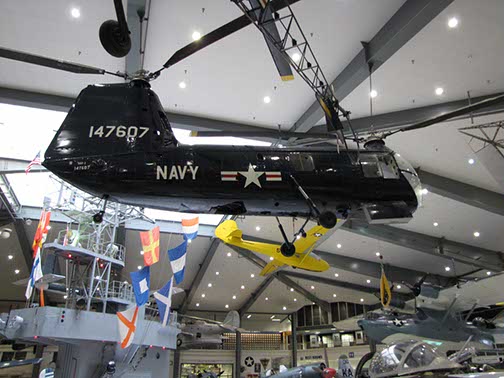NAS Pensacola
Nine photos from the Naval Air Station museum in Pensacola, Florida.
HUP-3 Retriever
Accepted by the Navy in April 1958 after having been operated by the U.S. Army, the HUP-3 Retriever on display in the museum underwent rework at the Overhaul & Repair Facility in Norfolk, Virginia, before assignment to Helicopter Utility Squadron (HU) 2 based at Naval Air Station (NAS) Lakehurst, New Jersey. Attached to squadron detachments, it operated from the aircraft carriers Forrestal (CVA 59), Lake Champlain (CVS) 39, Saratoga (CVA 60), and Randolph (CVS 15) during the period 1961-1962. Placed in storage at Naval Air Facility (NAF) Litchfield Park, Arizona, in late-1962, it was stricken from the naval inventory in March 1963 after having logged 1,323 flight hours. Eventually acquired by Mr. Glen Hyde of Roanoke, Texas, it was delivered to the museum in February 1988.
Notes Frank Piasecki's most notable flight was not his first, which came in the cockpit of a Barnstormer at the age of seven, but instead a trip aloft with Lou Leavitt when he was just a teenager. This ride in an autogyro with the first licensed rotary wing pilot in the United States set the young Piasecki on course to become one of the world's leading helicopter designers. Among his early interests was a design for a tandem-rotor machine, the first of which was the HRP, the shape of its canvas-covered fuselage inspiring the nickname "Flying Banana."
Its successor, delivered in 1949, bore little resemblance to the HRP, the HUPs Retreiver's appearance much less ungainly and its ability to meet its primary mission of search rescue advanced by the installation of a rescue hoist and floor hatch. The latter, wide enough to allow for the passage of a loaded stretcher, made the HUP ideally suited to performing plane guard duties. In this capacity, Retrievers rescued many an aviator who ditched his aircraft at sea during flight operations from an aircraft carrier. Additionally, later versions of the HUP were equipped with radar and flown in the antisubmarine role, the HUP-3 holding the distinction of being the first production helicopter equipped with an automatic pilot system, though its unreliability precluded it from seeing much utilization.
At the height of their career in the Navy, HUPs were carried aboard all aircraft carriers of the fleet, their compact fuselages allowing for easy stowage on board. One Retriever also made history on board another vessel on 4 August 1955, its wheels touching the deck of the submarine Nautilus (SSN 571) signifying the first ever landing of an aircraft on a nuclear-powered vessel.
A total of 339 production models of the Retriever served in the U.S. Navy and U.S. Army, with others procured by the Royal Canadian Navy and the French Navy.
Specifications
Manufacturer: Piasecki Helicopter Corporation
Dimensions: Length: 32 ft.; Height: 12 ft., 6 in.; Rotor Diameter: 35 ft. each
Weights: Empty: 4,132 lb.; Gross Weight: 6,005 lb.
Power Plant: Two 550 horsepower Continental R-975-46A engines
Performance: Maximum Speed: 120 M.P.H.; Service Ceiling: 12,467 ft.; Range: 357 miles
Armament: None
Crew: Two pilots and four passengers
Aircraft in the Museum Collection
HUP-3 (BuNo 147607)- On indoor static display
HUP-3 (BuNo 147600)- On loan to Kalamazoo Aviation History Museum, Portage, Michigan
